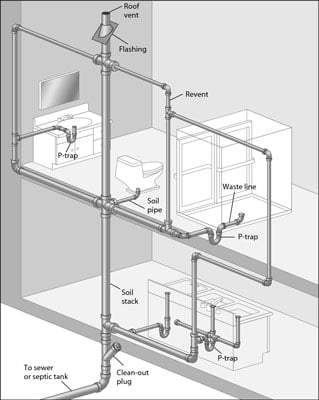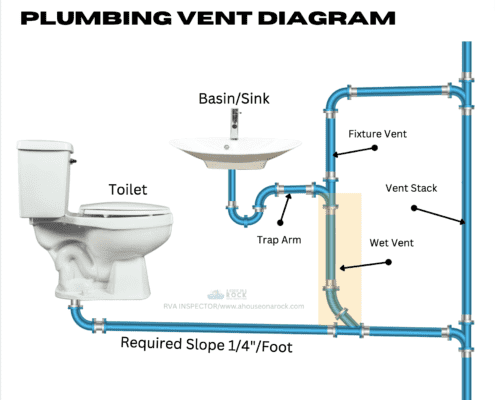Why Adequate Ventilation Is Critical in Plumbing Systems
Why Adequate Ventilation Is Critical in Plumbing Systems
Blog Article
The author is making several great pointers on Why Plumbing Air Vents Are Important as a whole in this great article underneath.

Correct ventilation in plumbing systems is typically ignored, yet it is vital for keeping the performance and security of your home's pipes. Ventilation helps manage atmospheric pressure, protect against the build-up of harmful gases, and make sure the efficient removal of waste. In this overview, we will explore the value of correct pipes ventilation, how it functions, and the benefits it offers your plumbing system.
Recognizing Ventilation in Plumbing
Ventilation in pipes describes the network of pipes that enable air to stream via the drainage system. These vents offer several purposes, including regulating atmospheric pressure within the pipelines, stopping sewage system gases from entering the home, and helping in the smooth circulation of wastewater.
Exactly How Ventilation Functions in Plumbing Equipments
Air Pressure Policy
Appropriate air flow maintains well balanced atmospheric pressure within the plumbing system. When water flows via pipelines, it displaces air. Without adequate air flow, this variation can develop adverse pressure, causing slow down drains or siphoning of water from traps, which can cause unpleasant smells to seep right into the home.
Protecting Against Drain Gas Accumulation
Among the most critical features of plumbing vents is to stop sewer gases, such as methane and hydrogen sulfide, from gathering within the home. These gases can posture severe health and wellness risks and are extremely combustible. Vent pipes permit these gases to run away safely outside.
Aiding in Waste Removal
Ventilation aids in the effective removal of wastewater by protecting against airlocks in the drain system. When air can stream openly through the vents, it allows water and waste to move efficiently with the pipelines, reducing the risk of blockages and back-ups.
Types of Pipes Vents
Key Heap Vent
The primary pile air vent, also known as the air vent stack, is the primary vent in a pipes system. It prolongs from the primary drainpipe line up via the roof, enabling gases to leave and fresh air to enter the system.
Branch Vent
Branch vents attach to the main stack vent and serve specific components, such as sinks, commodes, and showers. These vents guarantee that each fixture has ample ventilation to function effectively.
Air Admission Shutoff (AAV).
An Air Admittance Valve (AAV) is a one-way shutoff that allows air to go into the pipes system without the need for a standard vent pipe expanding with the roofing system. AAVs are commonly utilized in restorations or locations where mounting a typical air vent is not practical.
Indications of Poor Air Flow in Pipes.
Slow Draining Fixtures.
If your sinks, tubs, or toilets are draining gradually, maybe an indicator of inadequate ventilation. Inadequate air flow can produce a vacuum result, making it challenging for water to drain pipes correctly.
Gurgling Appears.
Gurgling sounds originating from drains pipes are usually an outcome of air being sucked through water catches as a result of negative pressure in the pipelines. This is a clear indication of not enough ventilation.
Unpleasant Smells.
Sewer odors inside your home are a red flag that your plumbing system is not correctly aerated. This might suggest that sewage system gases are not being sufficiently vented outside, bring about potentially harmful conditions.
Usual Ventilation Errors.
Inadequate Vent Sizing.
Making use of small vent pipelines can bring about bad air circulation and stress discrepancies in the system. It's necessary to make use of vents that meet the particular demands of your plumbing system.
Improper Vent Placement.
Positioning vents also far from the components they offer can reduce their effectiveness. Proper positioning ensures that air can move freely and efficiently through the system.
Ignoring Code Requirements.
Building ordinance offer certain guidelines for plumbing air flow. Ignoring these codes can result in a system that fails to work properly and might bring about expensive repair work or health hazards.
Advantages of Proper Air Flow.
Improved System Performance.
Properly aerated plumbing systems run more effectively, with fewer obstructions, faster draining, and less strain on the pipes. This effectiveness extends the lifespan of the plumbing system.
Improved Air High Quality.
By stopping sewage system gases from entering your home, appropriate air flow contributes to far better interior air high quality, making your living atmosphere healthier and extra comfortable.
Stopping Water Damages.
Adequate air flow assists avoid water from being siphoned out of catches, which can cause drain gases getting in the home and triggering water damage with time.
Actions to Make Certain Correct Ventilation.
Consulting Plumbing Codes.
Constantly seek advice from neighborhood plumbing codes when making or modifying your plumbing system. These codes offer the required guidelines for appropriate airing vent and guarantee your system satisfies security criteria.
Routine Inspection and Upkeep.
Routine evaluations can help recognize possible ventilation concerns before they become major issues. Upkeep tasks, such as cleaning up vent pipes and looking for blockages, are crucial for maintaining the system in good working order.
Expert Setup.
For brand-new setups or significant adjustments, it's important to employ a professional plumber. They have the knowledge to make certain the air flow system is properly made and set up according to code.
Final thought.
Correct air flow is a crucial component of any type of pipes system, ensuring that it operates successfully and safely. By comprehending the relevance of ventilation, recognizing the indicators of inadequate air flow, and taking actions to preserve your system, you can stop expensive problems and secure your home's air high quality.
4 Things You Should Know About Your Plumbing Vents
What Plumbing Vents Are
Also called a vent stack, a plumbing vent is a vertical pipe attached to your drain line that runs through your roof. The plumbing vent pipe, or plumbing air vent, removes gas and odors from your plumbing system and allows fresh air to enter the pipes, helping the water to flow out of the drain pipes.
What Plumbing Vents Do
Plumbing vents have two basic functions. One of which is to allow unpleasant smelling wastewater and sewer gasses to escape your plumbing system instead of entering your home. Plumbing vent pipes are typically located on roofs, away from windows, to ensure the fumes exit the home completely.
The other function of the plumbing vent is to move fresh air into your plumbing system. This helps move water through every plumbing fixture in your house, like toilets and sink drains. Think of the way in which you need to let a little air into the bottle as you pour soda in order to make the drink flow smoothly.
Different Types of Plumbing Vents
True vent: This is the most common vent option. In simplest terms, a true vent is a vertical pipe attached to your drain line that exits through the roof. They often function as the main vent that other fixtures can connect to. Re-vent pipe or auxiliary vent: Attached to the drain line near specific plumbing fixtures, re-vent pipes run up and over to connect to the main vent. Common vent: Two plumbing fixtures installed on opposite sides of a wall are typically tied into the vent stack using something known as a sanitary cross. Wet vent: This venting option operates as a drain pipe and a vent at the same time. Wet vent drainage systems drain water from one fixture while venting the air from another. Although they’ve been used for over 100 years, wet vent systems have only recently been added to the plumbing code in many areas. If you’re planning on installing one in a bathroom remodel, make sure you check your local code prior to construction. Loop vent: For free-standing fixtures like kitchen island sinks, loop vents are ideal. These vent pipes run under the floor, rise from the P-trap, and create a loop inside the cabinet sink. Air admittance valve: An AAV is a one-way mechanical valve typically installed at the site of the plumbing fixture. AAVs allow venting to occur without having to tie into a larger venting system. They’re ideal for venting fixtures where you aren’t able to easily connect to an existing vent system. Common Plumbing Vent Issues
Although vent pipes typically don’t have water flowing through them, they’re still subject to many typical plumbing issues. For example, clogs are one of the most common problems associated with sewer vent pipes. If your vent pipe gets clogged, all of your plumbing fixtures tied into the vent stack will be affected.
A sink with a slow drain that bubbles and gurgles or a strong sewage smell around your toilet are both indicators that your toilet vent pipe is clogged. Because most vent pipes exit through the roof, old leaves, twigs or even a bird’s nest could be clogging the pipe.
Clogs in your vent pipe system cause a buildup of negative pressure, meaning that water won’t be able to flow out of your home very well. It’s similar to putting your finger over the opening of a straw to trap water inside. When you remove your finger, the water is able to flow out of the straw.
If you suspect you have any blockage in your vent, make sure you have a professional come examine the situation. Left unchecked, a blocked air vent can lead to other costly repairs, like leaks and sediment buildup.
Under Pressure
Pipe vents are essential aspects of a home’s plumbing system. Owning a home means learning about all sorts of things you never put much thought into before. But by understanding as much as you can about the important systems of your home, you can keep those budgets intact and those anxiety levels low.
https://www.homeserve.com/en-us/blog/home-improvement/plumbing-vents/

We are very serious about The Upsides of Proper Ventilation in Plumbing Design and I really hope you enjoyed the piece. Are you aware of anybody else who is fascinated with the niche? Feel free to promote it. We truly appreciate reading our article about Essential Plumbing Vent Pipes: Understanding Their Role.
Schedule Now Report this page